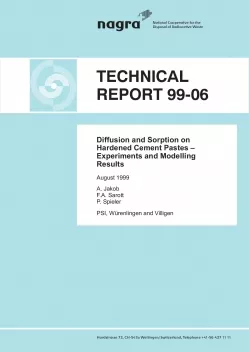
Technical Report NTB 99-06
Diffusion and Sorption on Hardened Cement Pastes – Experiments and Modelling Results
Large parts of repositories for low and intermediate level radioactive waste consist of cementitious materials. Radionuclides are transported by diffusion in the cement matrix or, in case of fractured or highly permeable cement, by advection and dispersion. In this work we aim at a mechanistic understanding of diffusion processes of some reactive tracers.
On the laboratory scale, ten through-diffusion experiments were performed to study these processes for Cl-, I-, Cs+ and Ni2+ ions in a Sulphate Resisting Portland Cement (SRPC) equilibrated with an artificial pore water. Some of the experiments continued up to nearly three years with daily measurements. In all the experiments, a cement disk initially saturated with an artificial pore water was exposed on one side to a highly diluted solution containing the species of interest. On the second side, a near-zero concentration boundary was maintained to drive through-diffusion of the tracer. The changes of concentrations on both sides of the samples were monitored, allowing careful mass balances. From these data, values of the diffusive flux and the mass of tracer taken up by the cementitious material were determined as a function of time.
In the subsequent modelling, the time histories of these tracer breakthroughs were fitted using five different models. The simplest model neglects all retarding mechanisms except pure diffusion. More complex models either account for instantaneous equilibrium sorption in form of linear or non-linear (Freundlich) sorption or for first-order sorption kinetics where the forward reaction may be linear or non-linear according to the Freundlich isotherm, while the back-reaction is linear. Hence, the analysis allows the extraction of the diffusion coefficient and parameter values for the sorption isotherm or rate-constants for sorption and desorption. The fits to the experimental data were carried out by an automated Marquardt-Levenberg procedure yielding error estimates of the fit-parameter values, correlation coefficients and also, as a measure of the goodness of the fits, the minimum values for the χ2-merit function.
Most of the models yielded an excellent agreement between measurements and calculated breakthrough curves but with best-fit values which are inconsistent with independent measurements. Kd -values from modelling through-diffusion experiments may be orders of magnitude smaller than values obtained using batch sorption experiments. The inadequacy of the models became obvious when the predicted tracer uptake based on the preceding best-fit parameter values was compared with measurements. As a rule, the models failed to predict the correct time behaviour of the amount of tracer taken up. Only caesium seems to act as a conservative tracer, because the simplest models approximately reproduce both the breakthrough curves and the experimental data for tracer uptake.
Finally, to obtain further information on the homogeneity of the specimens and retarding mechanisms, for two of the four nickel experiments, the boundary condition at the high-concentration side was changed to measure the out-diffusion of the tracer previously taken up. This was done by quickly replacing the high tracer concentration reservoir by a compartment with artificial pore water. In steady-state the concentration profile across the sample should be a linear function of space, and predictions based on a simple model are possible provided that the porous material is homogeneous. With such an experiment we were able to test this underlying assumption for a homogeneous tracer distribution. The analysis of both experiments, however, clearly demonstrated that such an assumption - for nickel as tracer - must be rejected.
